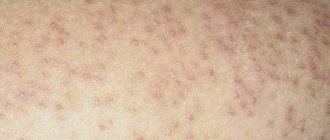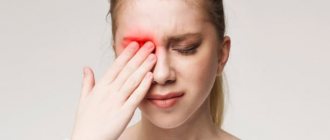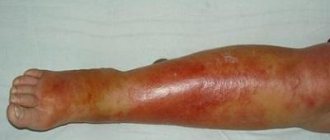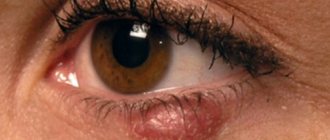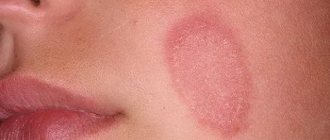Sometimes patches and home decongestants really “don’t work,” and if they do, it’s only as a placebo—after all, sometimes getting rid of “bags” and “circles” under the eyes is not as easy as it seems at first glance. In this material we will tell you why this aesthetic defect occurs in general and what correction methods exist. We talked about this with a cosmetologist Ishenina Natalya Petrovna
and have prepared for you an overview of the top and most effective procedures for the beauty of the periorbital area.
Let us immediately note that for some patients, according to individual indications, more radical methods of plastic surgery are indicated to solve the problem, for example, blepharoplasty
. Today this is the most effective way to quickly get rid of “bags” under the eyes forever. We will also talk about in what cases and why plastic surgery blepharoplasty is sometimes most appropriate in the article.
Symptoms of puffy eyes
Experts consider two options for swelling: when the eyelids, conjunctiva, orbits or subcutaneous tissue under the eyes swell. Both or one eye may swell, most often without additional symptoms. Unilateral swelling in the absence of other symptoms is usually not a cause for concern. But if there is severe swelling of the upper and lower eyelids (on one or both sides), it is worth checking your health. Along with swelling, the following symptoms may appear:
- limited vision (especially due to severe swelling);
- profuse lacrimation;
- photophobia;
- feeling of dryness;
- peeling of the skin.
Sometimes, with severe swelling, mucous discharge appears. They may have a sticky consistency, be wet or dried out. Swelling of the eyelids can also be accompanied by pain, redness, and irritation of the mucous membrane.
Indications for use
Treatments for bags under the eyes are prescribed for:
- swelling in the middle third of the face;
- pronounced nasolacrimal groove;
- general swelling of the face;
- dark circles under the eyes.
The procedures have contraindications. Among them:
- pregnancy, lactation;
- oncology;
- diabetes;
- chronic diseases;
- problems with blood clotting;
- violation of the integrity of the skin
and etc.
A cosmetologist will advise you on contraindications during a face-to-face consultation. As a rule, most patients are allowed to undergo procedures for bags and dark circles under the eyes.
Advantages
Smart medicine for smart people
Safe, effective and natural rejuvenation
The best technologies for communicating with patients
We don't just take care of your beauty - we recharge you!
Causes leading to swelling of the eyes
Short-term swelling, which goes away quickly and independently, is usually not associated with external factors, diseases, or physiology. More often it is caused by the following factors:
- poor nutrition (drinking large amounts of liquid before bed, drinking alcohol, addiction to smoked meats, spicy, salty foods);
- stress;
- cry;
- violation of wearing contact lenses;
- visual stress;
- individual characteristics of the body;
- violation of the work and rest schedule;
- bad habits;
- constant lack of sleep.
Other subjective symptoms of eyelid swelling include a burning sensation, blurred vision, and redness of the sclera. Usually they are persistent and pronounced, which once again confirms the presence of ocular or systemic diseases.
Causes of inflammation of the eyelids
Inflammation of the eyelids can be caused by the following reasons:
- pathological activity of mites living in the skin (a common phenomenon when the immune system is weakened);
- allergic reactions to certain types of medications, plant pollen, food;
- viral and microbial infections in the body;
- chemical, thermal and mechanical eye injuries;
- disruption of the cardiovascular and nervous systems;
- endocrine and hormonal disruptions.
1 Diseases of the skin around the eyes and inflammation of the eyelids. Diagnosis and treatment
2 Diseases of the skin around the eyes and inflammation of the eyelids. Diagnosis and treatment
3 Diseases of the skin around the eyes and inflammation of the eyelids. Diagnosis and treatment
Could swelling be a symptom of an allergy?
An allergic reaction is one of the common causes of swelling. This happens because mast cells release biologically active proteins to neutralize allergens. But when combined with irritants, they cause a reaction that is similar to inflammation. Hence the swelling and redness of the eyelids. Among the ophthalmological causes of eyelid swelling, the most common are:
- glaucoma;
- conjunctivitis;
- periorbital cellulitis;
- eyelid tumors;
- injuries;
- insect bites;
- thermal, chemical burns.
Often the appearance of swelling is the body’s reaction to smoke, dust and other irritants from the external environment.
Why does swelling of the eyelid occur?
The skin's ability to stretch, loose structure and a large number of blood vessels lead to fluid quickly accumulating in the eye area.
There are various reasons for the appearance of swelling of the eyelids, but from the symptoms you can understand what triggered fluid retention in the body.
If the swelling of the eyelid is bilateral, combined with other edema of the body, and the skin on the eyelids is pale and cold to the touch, this indicates renal or heart failure, as well as severe anemia.
Swelling of the eyelid also occurs with head injuries and angioedema.
Many inflammatory eye diseases, such as the following, are also accompanied by swelling of the eyelids:
- stye, abscess, blepharitis, contact dermatitis and other inflammations of the eyelids;
- diseases of the paranasal sinuses;
- acute purulent, pseudo- and membranous conjunctivitis;
- phlegmon, acute dacryocystitis and other diseases of the lacrimal sac;
- ednophthalmitis, iridocyclitis and other pathologies of the eyeball.
Swelling of the eyelids (most often unilateral) is characterized by redness of the skin, pain on palpation and a local increase in temperature.
Why does swelling occur in dry eye syndrome?
Dry eye syndrome (DES) is a pathological condition that is based on a violation of the stability of the tear film.
It provides nutrition, hydration and protection to the cornea. But when few tears are produced or their composition changes, the tear film quickly begins to evaporate. Because of this, the mucous membrane dries out, a burning sensation, itching, redness, and swelling appears.
Various reasons contribute to the development of dry eye syndrome. This could be taking antidepressants, antihistamines, working at a computer for a long time, or staying in a room with dry air. Dry eye syndrome may progress during sun exposure (summer) because too much air temperature causes tears to evaporate.
You can compensate for moisture deficiency with the help of tear substitutes. These are special drops that contain moisturizing components. But, despite the fact that they have a composition close to tears, they do not contain mucins and lipids, which help the tear film to adhere to the surface of the eyeball and maintain stability.
One of the effective ways to restore the tear film is the use of Delfanto® in capsules. They contain a record amount of antioxidants (at least 35%), which help stimulate the production of your own tears.
Treatment
Pre-hospital assistance
In case of burns, rinse the eye with running water. The use of alkalis and acids to neutralize the effects of chemicals is prohibited. For trauma patients, a bandage should be applied to provide rest and eliminate eye movements and visual strain. You cannot remove foreign bodies yourself, so as not to aggravate the damage. For all eye diseases, it is important to observe the rules of personal hygiene.
Conservative therapy
Conservative treatment tactics are determined by the cause of swelling under the eyes. The following drugs can be used:
- Painkillers
. Analgesics in drops are administered to reduce pain during the examination. Subsequently, tablet forms are prescribed. - Antibiotics
. In the first days, broad-spectrum antibacterial agents are used. After receiving the result of the microbiological study, the treatment regimen is adjusted taking into account antibiotic sensitivity. - Antiseptics
. Indicated for conjunctivitis, after removal of superficial foreign bodies. - Reparation stimulants
. Necessary for corneal damage due to wounds, erosions, post-traumatic defects. - Antihistamines
. Recommended for allergic diseases.
According to indications, parabulbar, retrobulbar, subconjunctival injections are performed. Physiotherapeutic techniques are used and eyelid massage is performed.
Surgery
Taking into account the nature of the pathology, the following surgical interventions can be performed:
- Traumatic injuries
: suturing the eyelid, conjunctiva or cornea, removal of foreign bodies of the conjunctiva and cornea, necrectomy and keratoplasty for burns. - Purulent processes
: opening of barley, dacryocystorhinostomy, vitrectomy, evisceration, enucleation of the eyeball. - Other eye diseases
: penetrating keratoplasty, corneal transplantation.
In the long-term period after injuries and purulent diseases, some patients require elimination of ptosis, correction of eversion or entropion of the eyelid, antiglaucomatous operations for secondary glaucoma, and other interventions.
What diseases can cause swollen eyes?
This symptom accompanies not only ophthalmological pathologies. It may be associated with systemic diseases. For example:
- gastrointestinal diseases;
- pathologies of the pituitary gland, thyroid gland;
- diseases of the gastrointestinal tract;
- infectious, viral diseases;
- liver and kidney diseases.
The list goes on, because there are more than 70 diseases that are accompanied by swelling of the eyelids. This could indicate problems with almost any organ.
Service cost
Treatment of bags under the eyes in cosmetology at the Marina Ryabus Clinic will cost individually in each case. Below are prices for the most popular services.
| Procedure/Drug | Price |
| Mesoai/Mesoscalpt (1 ml) | 14 700,00 |
| Liftera-A (ultrasonic lifting) eyes + forehead | 20 000,00 |
| Fotona Smooth Eye | 15 000,00 |
| Fotona 4D | 25 000,00 |
| Radiesse (1.5 ml) | 27 000,00 |
| Sculptra (5 ml) | 45 000,00 |
To make an appointment with a cosmetologist, write to us in any of the messengers (Telegram, WhatsApp, Viber) or call from 9:00 to 21:00 at the clinic: +7 (499) 397-71-30
Marina Ryabus Clinic is a center for anti-aging medicine with an approach understandable to business people. We clearly build a patient management strategy, show results at every stage and guarantee constant support on the path to excellence.
How to remove puffiness under the eyes?
It is difficult to immediately determine the cause of swelling. But you can try to eliminate provoking factors, for example, normalize your daily routine, diet, and get rid of bad habits.
If swelling is persistent, you need to seek medical help. Only a specialist can determine the reason why the eyelids are swollen and prescribe therapy.
If there is reason to believe that swelling of the eyelids is associated with everyday factors (crying, working at the computer, sleep disturbances, etc.), you can try to cope with this problem yourself. For example, using cold compresses. Cold causes blood vessels to contract, which reduces swelling.
Sometimes chilled tea bags can help relieve swelling quickly. Tea contains caffeine, which helps remove excess fluid from tissues. Tea bags must be applied for 15-20 minutes.
You can also try to remove swelling with massage (10-15 minutes a day). You also need to get good rest. Sleep should last at least 7 hours a day, and it is advisable to go to bed at the same time.
If swelling still periodically reminds itself, then you need to seek help from a specialist. Early detection of pathologies that cause swelling of the eyelids helps prevent serious complications.
If swelling is accompanied by a burning sensation, dry eyes, itching, irritation, you should take Delfanto® capsules regularly. They help increase the production of tear fluid by 89%, due to which the cornea and conjunctiva receive natural hydration.
Cosmetology procedures
Modern cosmetology offers various methods for correcting bags in the periorbital area.
- Mesotherapy is the introduction through microinjections of a vitamin-mineral cocktail with biologically active substances, hyaluronic acid. The composition is selected individually, after the administration of the drugs, metabolism in cells is stimulated, blood vessels are toned, and the skin is smoothed. This eliminates puffiness and bags.
- The laser removal procedure – fractional thermolysis, due to tissue microperforations, tightens and renews the skin, reducing the severity of the problem. In addition, the laser stimulates the synthesis of collagen and elastin fibers.
- RF lifting (skin tightening due to radiofrequency effects). Warming up the tissues helps in their compaction and contraction, stimulating metabolic processes, which enhances fluid drainage.
- The introduction of fillers helps to remove dark circles, and less often, to eliminate bags, especially if it is associated with gravitational ptosis. The choice of filler is important so as not to increase swelling. Sometimes lipolytics can be used, but this requires special indications.
- Botox or Dysport injections will not be effective in the fight against puffiness, but they can reduce wrinkles and relax muscles, indirectly helping to solve the problem.
- If all the measures listed above do not help, the problem progresses, the eye bags are very pronounced, there is ptosis of the eyelids, surgery to remove bags under the eyes is indicated. Various oculoplastic techniques will be performed; modern surgeons prefer to perform interventions in the least traumatic ways. This can be the removal or reposition of fat bags, the fetgrafting method (moving fat cells to the desired areas), browlifting or the pinch method, canthopexy.
Masks
There are effective eye masks that will help get rid of the problem.
Pull-up
Necessary:
- Take 10 g of rice flour and 10 ml of cherry seed oil.
- Mix and dilute with any herbal decoction.
- Soak cotton pads in the solution and apply to eyelids.
Nutritious
Necessary:
- Grind 3 strawberries into puree.
- Mix with 1 tsp. coconut oil.
- Cool and place the mask on your eyelids.
Moisturizing
Need to:
- Take 10 g of gelatin and dissolve in warm water.
- Add 5 g drops of shea butter.
- Distribute the composition over the centuries.
Such compresses and masks should be kept for 20 minutes. Then they need to be washed off with cold water. It is best to perform the procedure in the morning and evening.
Folk remedies
You can remove swelling on the eyelids using the following masks and compresses.
Potato
The easiest way is to cut off a few thin circles and place them on your eyelids. The tuber can also be grated and placed in a gauze bag.
Another recipe:
- Boil potatoes and grind into puree.
- Mix with egg.
It is allowed to add a little natural milk. The compress should be placed on gauze and kept in front of your eyes.
Parsley
Need to:
- Grind the leaves and roots in a meat grinder or blender. 2 tbsp is enough. l.
- Distribute the paste on the skin under the eyes.
Chamomile
Necessary:
- Place dry inflorescences into fabric bags.
- Keep in boiling water for 5 minutes.
- Apply them to your eyelids.
cucumbers
Just apply a couple of circles to your eyes. Another variant:
- Squeeze fresh cucumber and lemon juice.
- Mix in a ratio of 3 to 1.
- Soak cotton pads in the liquid and place on your eyes.
Tea
Required:
- Pour boiling water over a couple of bags.
- Cool in the freezer and apply to your eyes.
Coffee
Necessary:
- Take 5 g of soluble product.
- Mix with 10 ml yogurt.
- Moisten napkins in the product and place on eyelids.
Herbal collection
Recipe:
- Take equal amounts of chamomile, thyme and plantain.
- Pour 10 g of the collection with a cup of boiling water.
- Wait half an hour and add 15 drops of rosemary oil.
- In the composition, moisten the sponges and apply to the eyelids.
Starch
Need to:
- Mix 10 g of starch with an ampoule of retinol and 5 drops of sandalwood.
- Apply to the skin under the eyes.
Ice
You need to apply ice cubes to your eyelids. To create them, you can use not pure water, but a solution of 10 ml of cranberry juice and an ampoule of pantothenic acid.
Pumpkin
Necessary:
- Grind 15 g of the product into a paste.
- Add 10 ml of kefir and 3 drops of patchouli oil.
- Apply the composition to the area under the eyes.
Mint
Need to:
- Take 10 fresh branches.
- Squeeze the juice and mix with 5 ml of sour cream.
- Cool and apply to eyelids.
Milk
You will need:
- Mix 15 ml of liquid with 10 g of cottage cheese.
- Form into cakes and place on your eyes.
Apple
Required:
- Grind 1 fruit.
- Add the yolk of a chicken egg and 1 tsp. starch.
- Apply a thick layer to the area under the eyes.
Chocolate
Required:
- Melt 10 g of the product in a steam bath.
- Mix with 15 ml of cream.
- Apply to skin.
Oils
Used against swelling and oil. For example, unrefined oil is used for massage. The ideal option is grape or olive. Essential oils can be added to masks. It is best to mix several components.
For example, a warm solution of apricot oil and wheat germ is used for wiping. You can also mix chamomile, sage, mint oil and linden decoction.
Oral preparations
Folk remedies taken orally also help with swelling of the eyelids. Herbal decoctions are usually prepared. For example, they use the root of sageweed. You can mix 3 pinches of oats and a pinch each of horsetail, leuzea, and immortelle. The third option is 1 pinch each of rose hips, oats, flaxseeds, chicory.
Preparation:
- 1 tbsp. l. raw materials pour 210 ml of water.
- Boil for 4 minutes.
- Leave for 30 minutes.
- Take 1 tbsp. l. 3 times a day before meals.
These drugs have a mild diuretic effect.
Swelling in the morning due to ophthalmic diseases
Swelling of the upper eyelid is a common symptom characteristic of many eye diseases, especially inflammatory ones. Swelling can occur at any time of the day. But in the morning they are especially strong. Almost all symptoms intensify. During the night, more fluid accumulates in the intercellular space of the eyelids, including pathological fluid, so after sleep the swelling is more pronounced.
A symptom such as swelling of the eyelids is observed with conjunctivitis, blepharitis, barley, chalazion, dacryocystitis. Also, the eyes and eyelids swell with severe keratitis, uveitis and various inflammatory diseases that affect the internal structures of the eyeball.
The symptoms of ophthalmic diseases with inflammation are similar. There is no need to treat them yourself. Most of these pathologies can become chronic if treated incorrectly. This will subsequently affect your vision.
